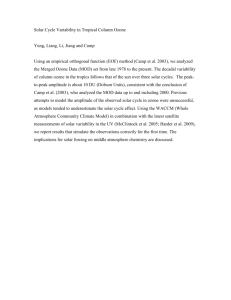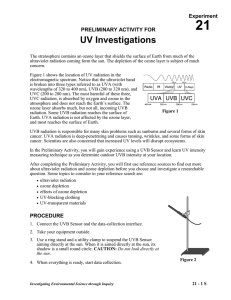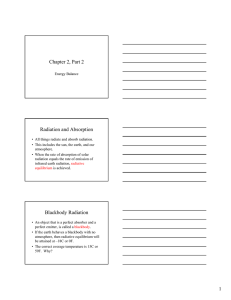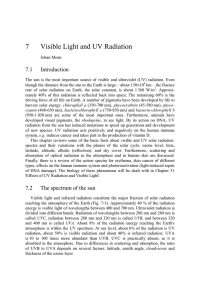Universidad Politécnica de Madrid (UPM) Elias Muñoz I S
advertisement
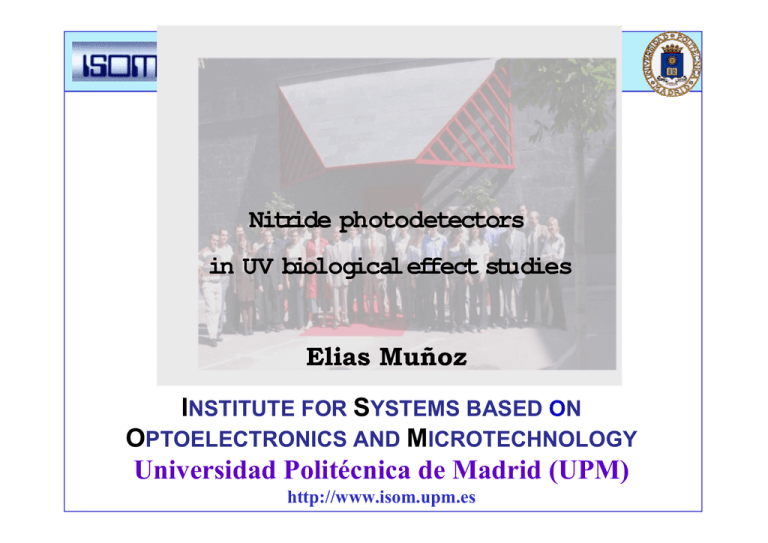
Nitride photodetectors in UV biologicaleffect studies Elias Muñoz INSTITUTE FOR SYSTEMS BASED ON OPTOELECTRONICS AND MICROTECHNOLOGY Universidad Politécnica de Madrid (UPM) http://www.isom.upm.es Outline a) Solar UV radiation • • • • Ozone and UV radiation UV biological action spectra Erythema (red skin) Life adapted to ozone absorption (DNA damage/repair) b) UV and biophotonics • • • fluorescence (dyes, fluorescent-proteins, microspheres) Quantum dots as fluorescent markers Lab-on-a-chip c) Nitride-III photodetectors • • • Bio Action Spectrum detectors. Erythema detectors AlGaN detectors Materials and processing issues. Problem areas • Conclusions Solar UV radiation Solar UV radiation (Photoactinic radiation) (%) Ozone absorption Ozone absorption 250nm wavelength nm Ozone and UV radiation The ozone hole Antartic station 03~3 mm = 300 Dobson units Ozone depletion and UVB changes 03~3 mm = 300 Dobson units Risks and benefits of solar radiation Risks • Sunburn •∙ Suntanning (pigmentation) •∙ Photoaging •∙ Skin cancer •∙ Malignant melanoma •∙ Local and systemic immune suppression •∙ Photosensitivity diseases •∙ Drug related phototoxic and photoallergic reactions •∙ Cataracts Benefits • Vitamine D synthesis • Phototherapy and photochemiotherapy • Psychological comforts UV action spectrum UV biological action spectra: basics photosynthesis PAR DNA absorption UV action spectra •λ λ<280 nm : bacteria killing (UVC water treatment at 250nm) biological action spectra DNA damage in humans Skin carcinogenesis in humans Erythema (red skin) UVB UVA UVC •Bio-complexity (damage and healing, repairing mechanisms) Solar UVB,...., skin cancer Minimum erythemal dosis and UV index RED SKIN •Weighted erythematic radiation: from 25 mW/ m2 up to 400 mW/ m2 •Minimum erythema dosis (MED) for red skin: 210 J/m2 •UV index: 1 to 16 Extreme (>9) High (7-9) Moderate (4-7) Low (<4) UV radiation and agriculture Inhibition of photosynthesis by UV illumination vs. time and UV wavelength Blue light benefits? Eye absorption and lamp hazards LIFE ADAPTED TO UV •After the BB (t=0) , organisms that survived to “UV springs” kept adapting to solar irradiation…to Earth´s atmosphere •Natural selection, genetic variants, repairing enzymes, •Fur, shells, pigments...protect! •Flavonoids, in plants; mycosporinelike aninoacids, in algae, and sea creatures, absorb UV (UVB!), protect! absorption •ozone absorption<> <>DNA <> •Life adapted! (λ λ>280nm) (J. Withgott, Natural History, Jul. 2001, 38) semiconductor UV bio-frontier • Life adapted to the UV photons reaching us from the Sun; • UVA-λ>320 nm low damage; UVB-280<λ<320 medium damage, and UVC-λ<280 nm high damage • UV biophotonics on earth: 280<λ<400 nm • The region λ<280 (cell/tissue high damage), requiring higher Al%: bacteria killing, water purification... • Erythema detectors: weighted standard response for comparative AS studies ABSORPTION OF LIGTH BY WATER •Optical comm. in water •Detection of contaminants (pesticides, detergents..) •Lab preparations


